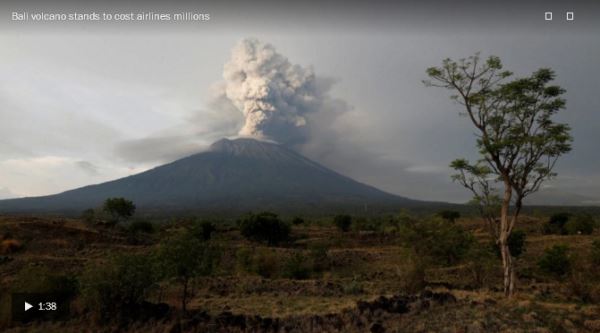More than 100,000 people in dozens of villages live around the base of Mount Agung, which sprung to life early last week. Thousands of tourists are trapped in a nightmare holiday with flights canceled in and out. A giant, suffocating ash cloud hovers over the island of Bali in Indonesia, and neither geologists nor local officials know what the simmering volcano will do next.
If Agung’s eruptions become more intense, it would be disastrous for the island, where the economy depends on tourism and agriculture. It could also alter global temperature for months — maybe years. Mount Agung has been actively erupting for a week, but it started to rumble in August. Since then, more than 140,000 people have fled their homes in the area, according to the BBC.
In 1963, when the volcano last erupted, it killed approximately 1,600 people over the course of a few months. The vast majority of those deaths were caused by the eruption’s pyroclastic flow — a high-speed wall of ash, debris and hot gas that surged down the mountainside. It was, essentially, a volcanic avalanche.
“A pyroclastic flow will destroy nearly everything in its path,” the U.S. Geological Survey said. “With rock fragments ranging in size from ash to boulders traveling across the ground at speeds typically greater than [50 mph], pyroclastic flows knock down, shatter, bury or carry away nearly all objects and structures in their way.”

As Mount Agung spurred the airport in Bali, Indonesia to stay closed, airlines braced for millions for dollars of lost revenue and scrambled to minimize damage. (Reuters)
The memory of that eruption was fresh enough Monday, when the Indonesian National Disaster Management Authority created a 7 ½-mile evacuation zone around the mountain — which includes more than 20 villages and around 100,000 people — and triggered the country’s highest natural disaster alert level.
“The current activity at Agung is pretty small-scale, although it is having a significant impact on local air traffic and the local population,” said Diana Roman, a geologist at the Carnegie Institution of Washington, who cautioned that it was impossible to predict what the volcano will do. “We do not have any basis for knowing whether this eruption will intensify, continue at its current level, or stop.”
With such little information to act on, officials aren’t taking chances. On Tuesday evening, a 30-minute tremor prompted warnings that a massive eruption could be imminent. If that occurs, the effect would extend well beyond Bali, into the global atmosphere.
In the short term, ash particles would cause regional cooling, as the layer of dust prevents some sunlight from reaching the ground. In the long term, sulfur dioxide would mix with water droplets in the atmosphere, spread across the globe and reflect sunlight for up to three years. Average global temperature could decrease significantly.
In 1991, Mount Pinatubo in the Philippines suddenly exploded. It was the largest eruption since the 1912 eruption of Novarupta on the Alaskan Peninsula. The explosion of lava, ash and rock injected a sulfuric acid aerosol cloud into the atmosphere. The cloud spread rapidly around the Earth, covering the entire globe in less than a year, and cooled temperatures by about 1 degree. Even the 1992-1993 El Niño could not overpower the cooling effect of the Pinatubo eruption, the effects of which lasted for several years.
“Large eruptions can also slow other aspects of climate change,” wrote Earther’s Brian Kahn. “Research published last year shows that the 1991 eruption of Mount Pinatubo in the Philippines cooled the oceans enough to momentarily depress sea level rise rates.”
Mount Agung’s 1963 eruption was “moderate” in size, Roman said, but it “emitted a relatively large volume of gas that did have a cooling effect on global temperature for about one year.”
The problem is, we don’t know whether Agung is just warming up on its way to a massive explosion, or whether it’s going to simply simmer.
“If the eruption does intensify there could be an impact [on global temperature], though it would depend on the amount and type of gas released as well as other factors,” Roman told The Washington Post. “In other words, it could do what it did in the ’60s, or it could do something completely different. We don’t know.”
(The Washington Post)